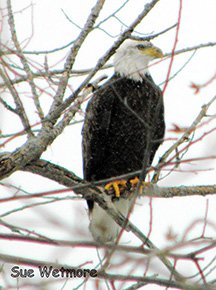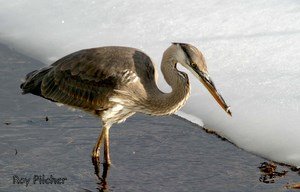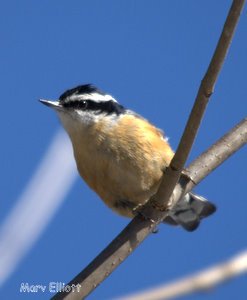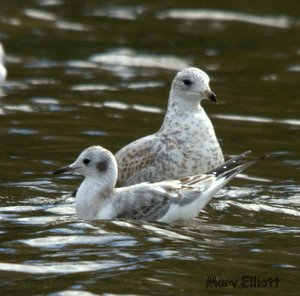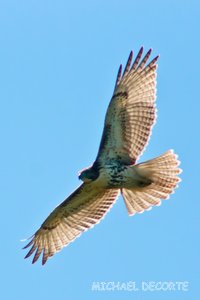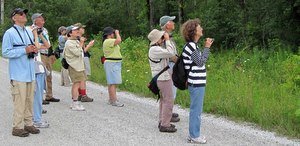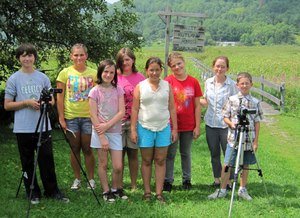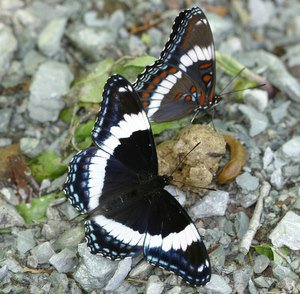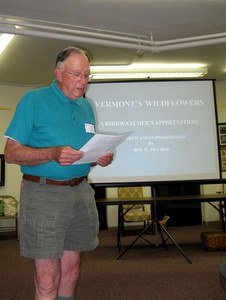Rutland County Audubon’s annual Century Count and Christmas Bird Count act as bookends to the year. Although the protocols are different, it is interesting to note that this year’s Century Count produced a record of 114 species, beating 2007’s record of 109. By contrast this past Christmas Bird Count had one of the lowest species count at 43 (the average is about 49).
On May 29, 20 birders gathered at 6 a.m. for Century Count XV. Armed with binoculars, spotting scopes, cameras, and notebooks, we set out to cover the county in our annual attempt to tally 100 species.
A trip around West Rutland Marsh produced Virginia Rail and Sora. A Marsh Wren was seen carrying nesting material. Warblers, mostly along Whipple Hollow Road, were Yellow Warbler, Chestnut-sided Warbler, Magnolia Warbler, Blackburnian Warbler, Black-and-White Warbler, American Redstart, Northern Waterthrush, Common Yellowthroat, and Canada Warbler. The highlight of the marsh, however, was not the warblers, but a male Orchard Oriole in full song along Marble Street. This was a first Vermont bird or life bird for many of the participants.
The Pleasant St. powerline in West Rutland was a successful stop as usual with Blue-winged Warbler (dressed and singing appropriately) and a feisty Prairie Warbler. An Eastern Towhee and a Field Sparrow were also observed.
One of the highlights of the day was our stop at the Rte 4 rest area, where a Cerulean Warbler  looking at the Cerulean Warblerwas singing and observed high in the trees. RCAS Co-president Roy Pilcher first observed this bird May 11 (16 years after he saw it at the same location). Again The Cerulean was a life bird for many. Another Blue-winged Warbler (also appropriately dressed and singing) was seen here as well as a Golden-winged Warbler singing a Blue-winged Warbler song. All the field marks indicated Golden-winged and not a hybrid. A hermit thrush nest was found with two chicks, one possibly a Brown-headed Cowbird, and two blue eggs, one with the egg tooth poking through. A Louisiana Waterthrush was also heard at this location.
looking at the Cerulean Warblerwas singing and observed high in the trees. RCAS Co-president Roy Pilcher first observed this bird May 11 (16 years after he saw it at the same location). Again The Cerulean was a life bird for many. Another Blue-winged Warbler (also appropriately dressed and singing) was seen here as well as a Golden-winged Warbler singing a Blue-winged Warbler song. All the field marks indicated Golden-winged and not a hybrid. A hermit thrush nest was found with two chicks, one possibly a Brown-headed Cowbird, and two blue eggs, one with the egg tooth poking through. A Louisiana Waterthrush was also heard at this location.
The Castleton College Nature Trail produced a Hairy Woodpecker nest with young, the second Canada Warbler of the day, and a Pine Warbler. A Broad-winged Hawk was seen and a Brown Creeper was singing.
The Lake Bomoseen/Hubbardton IBA produced Wood Duck, including a female with eight young, and a Cliff Swallow on its nest under the church eaves.
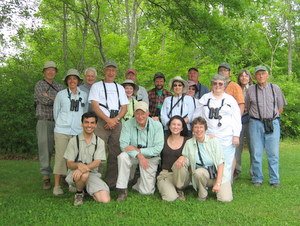 happy birdersAt our lunch stop at Bomoseen State Park, we observed a Herring Gull and Yellow-throated Vireo.
happy birdersAt our lunch stop at Bomoseen State Park, we observed a Herring Gull and Yellow-throated Vireo.
At the Kehoe Fishing Access at Lake Bomoseen, we heard a Tennessee Warbler singing, quite incessantly, for mid-day. Appropriately a Nashville Warbler was also heard at this spot. A Red-eyed Vireo was observed bringing in birch bark strips for its nest-building efforts.
A Blue-gray Gnatcatcher was seen at the Bird Mountain WMA in Castleton. No Peregrine Falcon activity was observed on the cliffs. However, two Red-tailed Hawks were seen soaring.
Wild Turkeys, a Brown Thrasher, a few Bobolinks, and two Eastern Meadowlarks were seen in Benson. Bank Swallows were seen entering and exiting their nests at the town sand supply in Brandon. The day ended at 9:20 p.m. at Lefferts Pond with, most appropriately, Great Horned Owl and Barred Owl.
Notably absent for the day were American Bittern, American Woodcock, Winter Wren, and Black-throated Green Warbler. A total of 28 checklists were submitted to eBird.
Total Species List:
Canada Goose
Wood Duck
American Black Duck
Mallard
Hooded Merganser
Common Merganser
Ruffed Grouse
Wild Turkey
Double-crested Cormorant
Great Blue Heron
Green Heron
Turkey Vulture
Northern Harrier
Broad-winged Hawk
Red-tailed Hawk
American Kestrel
Virginia Rail
Sora
Killdeer
Spotted Sandpiper
Wilson’s Snipe
Ring-billed Gull
Herring Gull
Rock Pigeon
Mourning Dove
Great Horned Owl
Barred Owl
Chimney Swift
Ruby-throated Hummingbird
Yellow-bellied Sapsucker
Downy Woodpecker
Hairy Woodpecker
Northern Flicker
Pileated Woodpecker
Eastern Wood-pewee
Alder Flycatcher
Willow Flycatcher
Least Flycatcher |
Eastern Phoebe
Great Crested Flycatcher
Eastern Kingbird
Yellow-throated Vireo
Blue-headed Vireo
Warbling Vireo
Red-eyed Vireo
Blue Jay
American Crow
Common Raven
Northern Rough-winged Swallow
Tree Swallow
Bank Swallow
Barn Swallow
Cliff Swallow
Black-capped Chickadee
Tufted Titmouse
Red-breasted Nuthatch
White-breasted Nuthatch
Brown Creeper
House Wren
Marsh Wren
Blue-gray Gnatcatcher
Eastern Bluebird
Veery
Hermit Thrush
Wood Thrush
American Robin
Gray Catbird
Brown Thrasher
European Starling
Cedar Waxwing
Blue-winged Warbler
Golden-winged Warbler
Tennessee Warbler
Nashville Warbler
Northern Parula
Yellow Warbler
|
Chestnut-sided Warbler
Magnolia Warbler
Black-throated Blue Warbler
Yellow-rumped Warbler
Blackburnian Warbler
Pine Warbler
Prairie Warbler
Cerulean Warbler
Black-and-white Warbler
American Redstart
Ovenbird
Northern Waterthrush
Louisiana Waterthrush
Common Yellowthroat
Canada Warbler
Eastern Towhee
Chipping Sparrow
Field Sparrow
Savannah Sparrow
Song Sparrow
Swamp Sparrow
White-throated Sparrow
Scarlet Tanager
Northern Cardinal
Rose-breasted Grosbeak
Indigo Bunting
Bobolink
Red-winged Blackbird
Eastern Meadowlark
Common Grackle
Brown-headed Cowbird
Orchard Oriole
Baltimore Oriole
Purple Finch
House Finch
American Goldfinch
House Sparrow |
 Staying Connected studies the corridors where wildlife moves from one forested patch to another and works with landowners and communities to maintain the connections.If you think back to times when you have seen wildlife - not just deer or turkeys, but the more elusive bobcats, black bears, weasels, or coyotes - chances are that you saw these animals in one of two areas: crossing a road or opening, or visiting a place with easy food like a bird feeder or chicken coop. These aren't the areas where the animals spend most of their time; these secretive creatures generally prefer forest cover or wetland shrublands. Our sightings represent the brief flashes of time that these animals appear in the open - when the reward of food outweighs the lack of protection or when the need to cross from one covered area to another is required in order to find food, a mate, or to maintain a home range. These aren't places where they spend their time; they're places where we spend ours.
Staying Connected studies the corridors where wildlife moves from one forested patch to another and works with landowners and communities to maintain the connections.If you think back to times when you have seen wildlife - not just deer or turkeys, but the more elusive bobcats, black bears, weasels, or coyotes - chances are that you saw these animals in one of two areas: crossing a road or opening, or visiting a place with easy food like a bird feeder or chicken coop. These aren't the areas where the animals spend most of their time; these secretive creatures generally prefer forest cover or wetland shrublands. Our sightings represent the brief flashes of time that these animals appear in the open - when the reward of food outweighs the lack of protection or when the need to cross from one covered area to another is required in order to find food, a mate, or to maintain a home range. These aren't places where they spend their time; they're places where we spend ours. Larry Miller captured a photo of this bobcat and sent it to Staying Connected.Staying Connected is asking people to report sightings of wildlife - especially large mammals - throughout Rutland County. A website, found here, allows users to report animals they have seen, as well as to see a map of the animals reported by others. Check it out! And the next time you see a black bear, moose, or another animal, let us know!
Larry Miller captured a photo of this bobcat and sent it to Staying Connected.Staying Connected is asking people to report sightings of wildlife - especially large mammals - throughout Rutland County. A website, found here, allows users to report animals they have seen, as well as to see a map of the animals reported by others. Check it out! And the next time you see a black bear, moose, or another animal, let us know!






